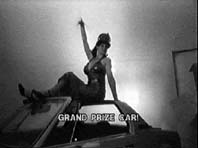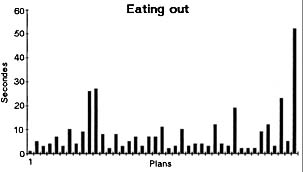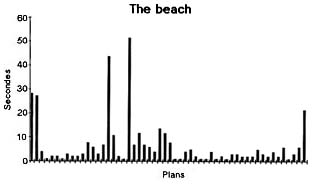2.1
Movement and time
To begin with, it seems obvious that the idea of movement is closely bound up
with that of time. Deleuze, referring to Zeno's arrow, points out how movement
cannot be thought of as a series of positions in space on which time descends
to confer homogeneity. He makes the distinction between what he calls
movement images, "moving cross-sections of duration", and time
images. Movement, indeed, defines for him what a shot is in cinema:
"a shot is what determines the movement to be established in the closed
system."[7]
2.2.
Depicted movement
Next, there are two types of movement which are to be distinguished between. On
the one hand, there is movement inside the fixed frame of an image, as
the relations between the elements of the image, of the shot, change; Deleuze
calls this "relative movement". Then, on the other, there is movement of the
camera-an overall change, which can be called "absolute". There is thus a
distinction to be made between what may be called "depicted" movement (as in
the Lumière shots) and "depictor" movement, which has come to be
something essential in cinema; where the former refers mainly to diegesis, the
latter refers above all else to film technique[8]. Even so, it would be naïve to want to
attribute "more" reality to the former. Not only is it not true that "the
camera cannot lie": a camera cannot help but give expression to the particular
point of view of someone lying behind it.
2.2.1. The frame What first determines an image is its frame. Bringing an element inside the frame not only causes it to exist, cinematographically speaking, but also determines how it is to exist. In Eating Out, for example, at no time do we see the characters' feet. They have no particular role to play for the director: they could have denoted the nervousness of the gangster or the calmness of the cook; but they do not get into the picture-fail to exist. In a study which is no longer recent but which had a considerable impact in Germany, Bernard Wember[9] shows how TV report makers systematically favour animated over still elements, preferring a flag waving in the wind to one hanging down its pole, or focusing on the moving parts rather than on a whole but immobile machine, etc. This finding is easy to check out: The Beach, for example, displays almost constant movement, what with the wind on the beach itself, bending plants and blowing people's hair around, and the endless breaking of waves; and Eating Out is equally beset by steam from the cooking and a host of glances and gestures. All this, of course, has a structural function within the story, and a symbolic significance too; but equally it constitutes a permanent call on the spectator's retina.
2.2.2. Position in the image It was Arnheim who first pointed out how the Western tradition gives pride of place to the centre in pictorial representations. Movement in this centre (e.g., the hamburger in the opening shot of Eating Out) is more strongly felt than, say, the sea-swell in the peripheral background of The Beach. Another significant dimension concerns the relation between a movement and the eye-to-camera axis. Movements parallel to the surface of the screen, such as the games at the beginning and at the end of The Beach, seem to be at a distance, "addressed", in every sense of the term, to the audience. A movement along the viewing axis, on the other hand- such as that of the man running up towards the women in The Beach-comes across altogether more aggressively. And the "response" comes along the same lines. The audience is made to feel they may turn into the actors. A look or a gaze can carry the same signification, as in the eye-contact with the TV host in The Price is Right. This is direct involvement using the phatic aspect.[10]
2.2.3. Quantity Any framing will display a greater or lesser number of elements[11], or, in other words, "the duration effect is inversely proportional to the information rate."[12] And, when information is in movement, this accentuates its perceptual density; this can indeed reach saturation point, as is the case in action films and in many video clips. What then counts is the fragment image[13], pure sensation, the virtuosity of the medium itself, its "image intensity" and speed... Then, on the other hand, there may be rarefaction: we have noted, above, that most of the short-film shots analysed here are animated by some movement; yet the opening of The Beach is slow: its movements disappear into the repetition of the principal visual elements, the sand and the sky, in the chosen angle which has the effect of distancing everything.
2.2.4. Length of shot Changing shots inevitably induces movement. The longer the shot, the less the editorial movement. Nevertheless, the absolute length of the shot in itself means little, and becomes significant only relative to other shots: five seconds is a long time in a rock-music clip and next to nothing in a Marguerite Duras film. If the beginning of The Beach seems so slow, it is because shot 1 lasts 29 seconds and shot 2 28, the two being moreover linked by a fade-through associating tracking and a panoramic shot to pursue the movement at a natural rhythm.
The Price is Right.The viewpoint is another important element in framing. It can represent the viewpoint of a character, as the low-angle shot of the man represents the view of the women in The Beach, or some more abstract, remote point of view- or the director's, as, for example, the low-angle shot of the woman in curlers in The Price is Right, which makes her even more ridiculous by exaggerating her mummery and movement.
2.3.1. Zoom The zoom is an effect much more well-loved of reporters than by directors, no doubt because it is so visible and seems to be showing off technique too blatantly. It appeals most particularly to amateur camcorder owners. So it will come as no surprise that only two instances of it are to be found in the present corpus, and those two very close together: in The Price is Right, there are two shots of the hero sleeping, taken with an overhanging camera; it is indeed a moot point whether it is a matter of zooming or just moving the camera, so short is the distance travelled... But, one way or the other, this movement has the effect of taking us inside the sleeper's dream. An exceptional procedure for an exceptional effect.
Soft-focus panoramic from TV host to car in The Price is Right
Panoramas, whether as such or as mere camera movement, are a variation on centering. Putting out of view what was in view and bringing in what was out, they multiply centering, all from one viewpoint. They are used for two things in particular: firstly, for presenting a place, as in the opening shot of The Beach, or some specificity of a place, as in the rapid movement from host to the car to be won in The Price is Right. In such cases, the movement is featured, displayed as such-slow, to express calm, in our first example, and fast to evoke the pace of a television programme in the other. Secondly, they are used for following an action-and here it is as if the movement contained in the action masks that of the camera in a mere amplification.
2.3.3. Tracking In tracking, the image picks up the movement of its support, with the direct result of accentuating the audience's involvement in the action. The tracking in shot 2 of The Beach takes us "onto" the beach, and tracking the legs of the woman and the running child is meant to help us, as them, forget the difficult scene just before.
3. Some functions
From shot 1 of Eating Out.
3.1.
Eye-catching
Eating Out starts off with a violent movement which virtually flings us
"into" the hamburger. This narrative technique, known in literature as "in
media res", has the effect of plunging the reader or spectator straight into
the heat of the action; only later will he or she get to find out the
spatio-temporal reference points for the story, the protagonists and the
narrative relations between them. Coming right after the black lead-in, a black
hot-plate carries us gently through the transition, but then a hamburger
falling "out of the blue" catches the eye and focuses the spectator's
attention, giving the scene from the very outset that climate of violence which
is to be one of its dramatic features. The extreme shortness of the shot,
unique in the film (see chart below), confirms its significance.
A graph plotting a film's shot times helps show up its time structure. Analysing The Beach shows how its structure is upheld by the rhythm set by the shots. Following the presentation (shots 1 to 15, average time = 6", showing the setting: beach, wind, protagonists), the confessions (shots 6 to 28) need time (average = 14"), although allowed by a most Bergmanesque feminine complicity, and set the plot. The third sequence (shots 29 to 40) is very quick- little over 2" per shot on average: this is the discussion which rapidly turns into the woman-friend's attack on the husband. This vengeance is a moment of drama in its unusualness and violence, its suddenness enhanced by the contrast with the preceding scene, which was soft and slow. The ending (shots 41 to 54) is played out at exactly the same rhythm (6"/shot) as the opening: on the beach, life goes on as though nothing had happened; the final shot is long, as if to echo the two equally long opening shots. The terms themselves chosen to describe these various phases make one think of classical tragedy- as was no doubt the author's intention. In their average durations from sequence to sequence, the shots form an integral part of the narrative structure and of its dramatisation.
3.3.
Highlighting
Movements can also send a "meta" signal to the audience. Whether by
concentration or absence, by speeding up or slowing down, the director has here
at his or her disposal a way of saying, as it were, "Watch! this is
important..." At one point in The Price is Right, the two TV game-show
contestants are down on their hands and knees; the slow-down shows the
difficulty they are having in reaching their goal-victory. And it also
highlights human folly: these contestants are prepared to sacrifice their
identities-their names, habits and skills-and revert to an animal state in
hopes of winning. The woman contestant's immaturity is confirmed by the antic
round she dances with the host on winning-while the unlucky loser has very slow
movements, underscored by the accompanying music. In the same film, the
protagonists, generally slow because shy, move fast when they meet, rushing as
it were to hide their embarrassment-which, of course, only succeeds in making
matters worse, as their heads bang together and the display is knocked
over...
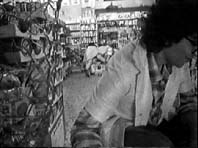 The Price is Right. |
Eating Out The Beach The Price is Right Film length 5'34" 6'19" 15'36" Number of shots 41 54 182 Average shot length 8.1" 7" 5.14"
The number of shots in relation to total length gives a general idea of the rhythm of a sequence and hence of the genre concerned[14]. The figures bear out the audience's impression: the first two films are "slower" than the third. The primary effect of long shots is to set the audience free, with time to explore the image and such information-rich parts of it as faces. The second effect is to send another meta-signal, to say that there is something not obvious to be looked for here- feelings, in particular. Long silences or expressive music reinforce such a hypothesis, reminiscent of the way a reader is called on to co-construct the story, as described by Umberto Eco.[15] In short, what we have here is one of the topoi of cinema, a "psychological film" as the critics would say. With its faster rhythm, The Price is Right is playing a different ballgame: that of a comic film which does not dwell on its funny sequences so as not to come over as "corny". This speed contrasts with the slow clumsiness of the characters and the dead-weight of their silences, as already mentioned. Alternation is one of the main threads running through the story and helps hold the audience's attention. As in music, tempo variation is one of the structural factors in the film image.
This impression is no doubt to a large extent formed by the relationship between projection-time and story-time-how much time is supposed to pass in the story. Eating Out and The Beach have a "real time" quality, as though filmed in one shot. The Three Unities of classical tragedy- time, place and action- are respected, although it is true that the very shortness of these shorts would tend to preclude any other, more complex narrative strategy. The time-span of The Price is Right, on the other hand, is vague, but is of at least a few days.
3.5.
Quotation movement
The Price is Right makes play of the audience's cultural habits. The
satire sequence, halfway between musical and commercial, and the game-show
sequence involve a stepped-up tempo, in parody of the forms being imitated.
Speed is meant to fascinate as well as to discourage zapping. Along with the
bright lights, the camera-eye-contact and other signs, movement also adds its
own touch of authenticity. Quotation may also, however, be of a much more
general sort. Cinema has an extraordinary mimicry function, evoking various
specific registers by the various movements it displays. TV and cinema
audiences both decode very often by constructing meaning in terms of genre. One
element indicating genre is movement. Obviously, there are going to be
counter-examples- but these are to be analysed as such. As far as the films
under analysis here are concerned, what we have is a "psychological whodunit"
in the case of Eating Out, a "drama" in the case of The Beach,
and a "satire" in the case of The Price is Right.
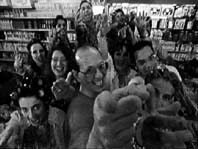 The Price is Right. |
3.6.
Special effect movement
Playing with movement is a way of playing with time: for example, when the
characters' movements slow down, the spectator is very quickly able to decode
this procedure, accepting it in the same way as editing is accepted. In the
former case, film time is longer than absolute time, and, in the second,
shorter. Reserved for key moments, such as immanent death or intense
reflection, this dilation of time is often expressed by means of slow movement,
or even slow motion. In The Price is Right, this serves to emphasize
ridiculousness-the contestant is on all fours, with a toilet brush in one
hand-while also impersonating the heroes of "great" cinema undergoing some
inner struggle between the calls of duty and love.
4. Conclusion
Movement thus puts us in a Batesonian double bind, "naturally" catching the eye and attracting interest, while equally capable of blinding and destroying the capacity to think. These serious artistic productions are a far cry from the visual terrorism wreaked by certain TV programmes- indeed by certain TV channels, and notably the most popular: the "tetanisation, vertigo, overexcitement and a state of shock wiping out judgement and any system of evaluation"[16] referred to by Paul Virilio are not involved here. Yet movement remains nevertheless fundamental to cinema, and it is no accident that the cinema is a child of the 20th century, century of revolution in transport and transmission. Taken to its extreme, movement becomes speed, "one of the poisons of this civilisation of ours which externalises, disjoints, cuts up and accelerates everything it touches."[17] And yet one might reply, with Pascal, that "our nature lies in movement; rest is death"[18]. Movement is what makes happen, fascinates, causes our body to accept immobility while our eyes scour the world. It is all no doubt a matter of proportion.
1 Jean-Claude Seguin, Michelle Aubert, La production des frères Lumière, catalogue and CD-ROM, Bifi.
2 We shall leave to one side any movement of the projection system
itself, as this is usually separated from the cinema audience and does not
exist in the case of the TV audience.
3
...as already mentioned by Søren Kolstrup in his article "The Film
Title and its Historical Ancestors or How did we get where we are?" in
p.o.v. n[[ring]] 2.
4 It must be said that present-day viewing conditions are
seldom quite those of the time. Anyone who has not had the opportunity of
viewing these shots with the accompaniment of live piano-playing will fail to
realise to what an extent the rhythm of the sequences is set by the music. For
the sake of simplicity, we shall restrict ourselves here to information carried
by the image itself.
5 These are the "ouistiti", "paluche" and "louma" cameras.
See Philippe Viallon, "La vérité de la paluche : entre technique
et réalité" in 10. Congrès de la SFSIC,
Grenoble-Echirolles, 1996.
6 Gilles Deleuze, L'image-mouvement, Les Editions de
Minuit, Paris, 1983, and L'image-temps, Les Editions de Minuit, Paris,
1985.
7 Gilles Deleuze, L'image-mouvement, op. cit., p.
23.
8 Knut Hicketier distinguishes between "die Bewegung vor
der Kamera und die Kamerabewegung", in Knut Hicketier, Film- und
Fernsehanalyse, Metzler, Stuttgart, 1993, p. 63.
9 Bernward Wember, Wie informiert das Fersehen? Ein
Indizienbeweis, List Verlag, Munich, 1976.
10 This aspect of Jakobson's typology has been most
effectively applied in the analysis of eye-movement on television made by
Eliséo Véron in "Il est là, je le vois, il me parle" in
Communications, n[[ring]] 38, pp 98-120.
11 Philippe Viallon, Analyse du discours
télévisuel, Presses Universitaires de France, 1996, pp
68-69.
12 André Gardies, Le récit filmique,
Hacette, Paris, p. 94.
13 Jean-Marc Vernier makes this three-fold division into
"depth image", "surface image" and "fragment image", in "Trois ordres de
l'image télévisuelle" in Quaderni, n[[ring]] 4, pp 9-19.
14 For films as for television productions, this notion of
"genre" is highly arbitrary, but is nevertheless essential to reception
processes and in particular to viewing strategy.
15 Umberto Eco, Lector in fabula, Grasset, Paris,
1985.
16 Paul Virilio, L'art du moteur, Galilée,
Paris.
17 Edgar Morin, Penser l'Europe, Gallimard, Paris,
1988, p. 205.
18 Pascal, Pensées, II, p. 129.

